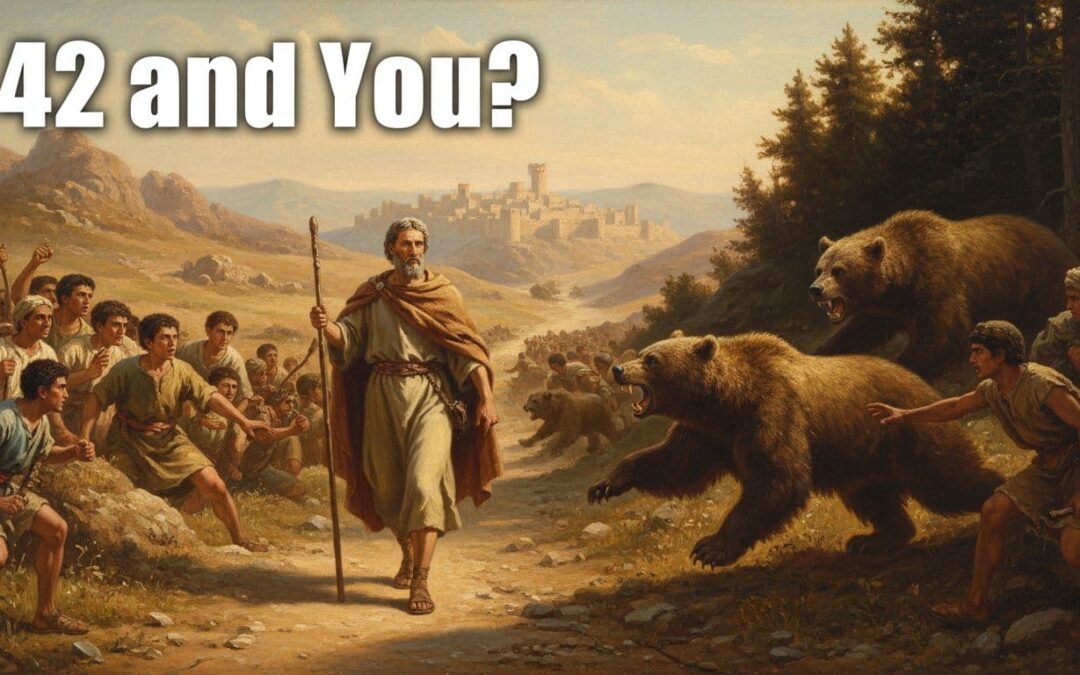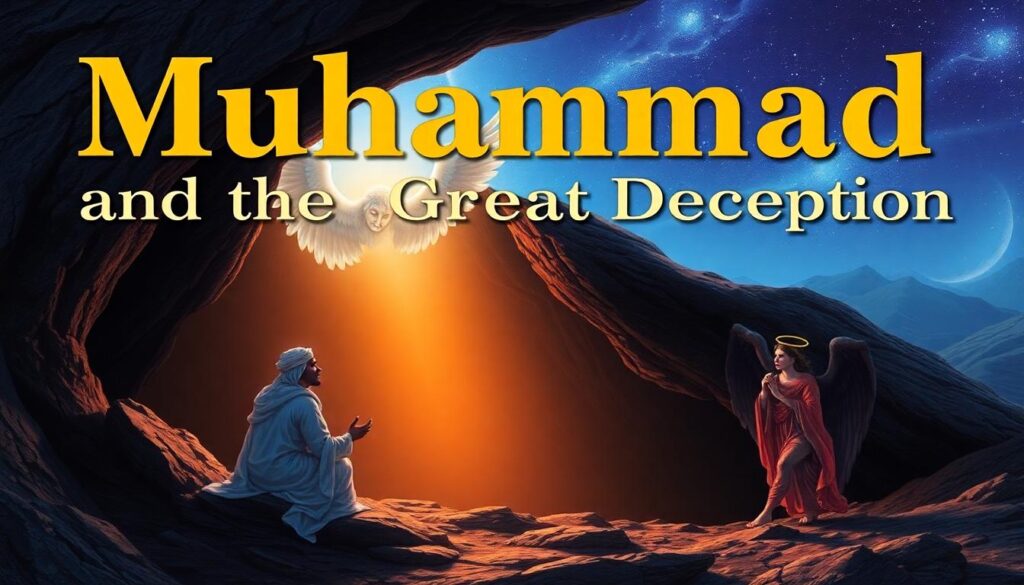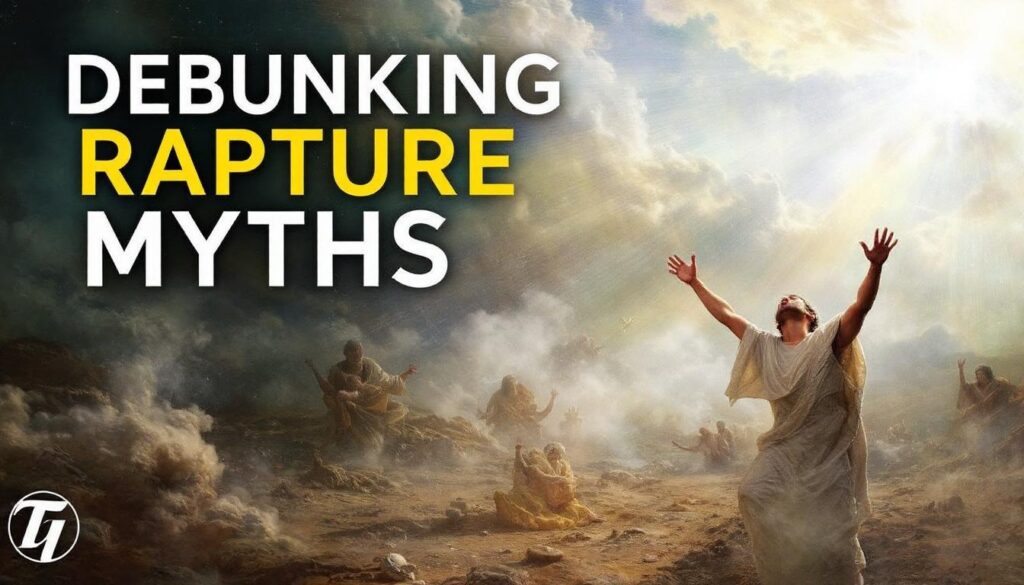2 Kings 2:23-25, the Number 42, and the Tribulation: How God Measures Justice and Protects His People
Some Bible stories are hard. Elisha walks toward Bethel. A group comes out, mocks him, and two she-bears maul forty-two of them. Is that random? Is it cruel? No. This is a case of measured justice, God protecting His message and His people after He put His hand on a new prophet.
Here is the promise of this article. We will explain this story in plain words, with the original Hebrew, and then show how the number 42 points to a set time of testing in later prophecy. We will show how it fits the seven-year Tribulation, why God does not pour out His wrath on His people, and how this fits God’s plan from Abraham through Ishmael and Isaac. Keep a Bible handy. We will move step by step and keep it clear.
The key idea is simple. The number 42 in 2 Kings is not a throwaway detail. It matches a pattern in Scripture, a set, limited time of testing and judgment. It points ahead to the 42 months in Revelation, the time when evil rises for a short season, and God still keeps a remnant safe.
2 Kings 2:23-25 in the original Hebrew, made clear
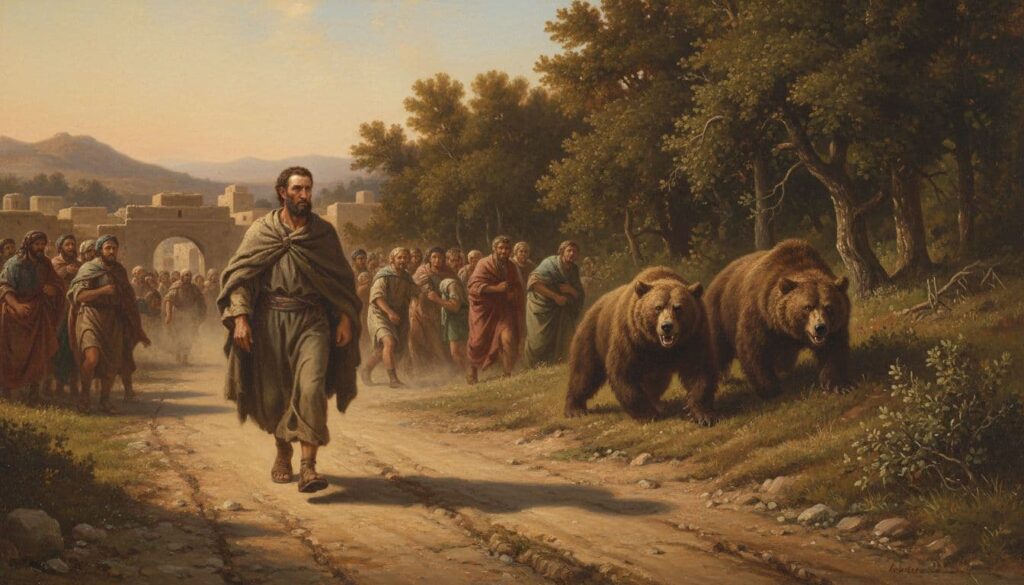
Elijah has just been taken up to Heaven. Elisha now wears the mantle of God’s prophet. He walks toward Bethel, a place that had become a center of false worship in Israel. This city taught people to reject the true God, so it is not surprising that trouble comes.
Three Hebrew words help us understand the scene.
- na’ar means youths or young men. Not toddlers. Likely a group large enough to act like a gang.
- ’aleh means go up. It is a taunt. “Go up like Elijah,” as if Elijah’s taking was fake and Elisha should vanish too.
- qereach means baldhead. It is a slur meant to shame God’s chosen servant.
They are not teasing a stranger. They are mocking God’s sign and God’s spokesman, right after God confirmed Elisha’s call. Elisha responds in the Lord’s name. Two she-bears come out and maul 42 of them. The text says “maul,” not “kill,” which also shows restraint. The number 42 signals a counted act of judgment on covenant mockery.
If you want a deeper background on this passage, see this clear explanation on why Elisha’s curse was not about kids and name-calling but a public rejection of God’s authority: Why did the Prophet Elisha curse the “youths”?. For another helpful read on the context and language, including Bethel’s idolatry and the meaning of the taunt, see The Misunderstood Story of Bear Attacks, a Bald Prophet, and Forty-Two Mouthy Kids.
This story is a small picture of a bigger truth. When people mock God’s rule, judgment comes. Yet God sets limits. He numbers justice. The number 42 in this history sets up the 42 months in prophecy.
Who were the youths (na’ar) and why their mock matters
The word na’ar can mean teen or young adult, even a servant or soldier in some contexts. Here it points to organized harassment, not child play. They come from Bethel, a place long tied to idols. The city’s history shaped a culture that treated God’s prophet with contempt. Mocking the messenger is mocking the God who sent him. That is the heart of the problem.
What did “Go up, baldhead” (’aleh, qereach) mean?
“Go up” throws shade at Elijah’s faithful departure. It rejects God’s sign. It tells Elisha to disappear. “Baldhead” is a cutting insult meant to strip honor and silence God’s voice. Their words deny the miracle and despise the mantle God placed on Elisha.
Why the bears and the number 42 show measured judgment
Two bears, not twenty. Forty-two mauled, not the whole crowd. God counted it. Justice lands, but it is limited and purposeful. Numbers often teach. Here the number 42 tags the event as measured judgment on public rebellion. That same number returns in prophecy as 42 months, a set time when God allows opposition to rise, then He answers.
Why the number 42 points to 42 months and the Great Tribulation
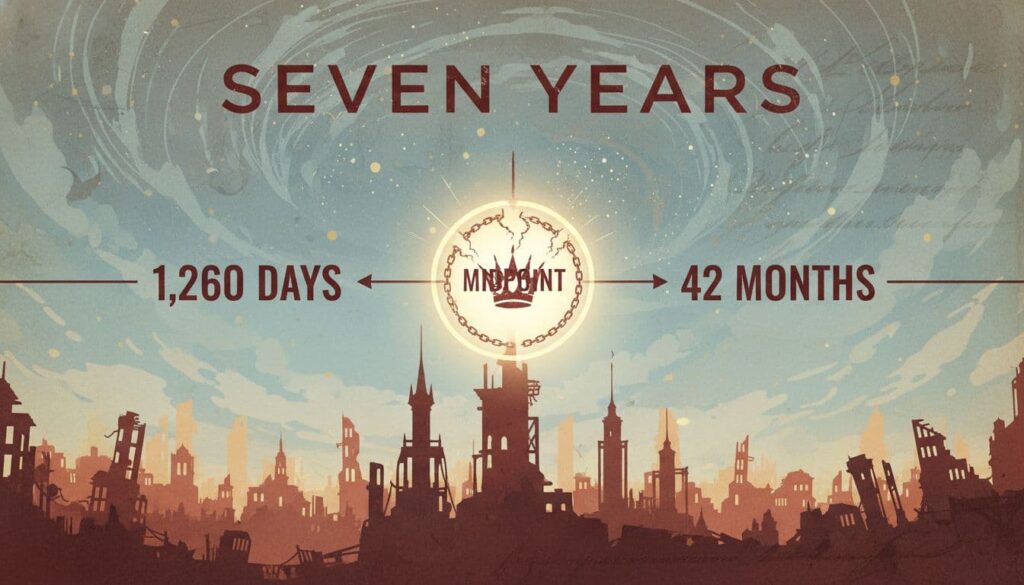
Scripture links 42 months with 1,260 days and with the phrase “time, times, and half a time.” Each one equals three and a half years. Several key texts tie together to form the seven-year Tribulation, split into two halves.
- Daniel 9:27 frames a final seven-year period.
- The midpoint brings the abomination of desolation, which Jesus highlights in Matthew 24:15.
- After that, Jesus says there will be Great Tribulation, a time of intense pressure and deception (Matthew 24:21).
The number 42 keeps showing up in that back half. Evil seems to surge. The beast is granted authority, but only for a short, fixed window. God allows a set time, then He acts. For a helpful overview of the forty-two months in Revelation, see this summary: What is the significance of the forty-two months in Revelation?.
So which half does 2 Kings 2:23-25 picture? The bold, public mockery, the sharp and counted judgment, and the match with 42 months in Revelation 13:5 point to the back half, the Great Tribulation. During that window, the beast acts with loud pride for 42 months. At the same time, God keeps His witnesses and preserves His people for a set number of days. Justice is certain, and the time is limited.
Where the Bible uses 42 months, 1,260 days, and time, times, half a time
- Revelation 11:2, the nations trample the holy city for 42 months.
- Revelation 11:3, the two witnesses prophesy for 1,260 days.
- Revelation 12:6 and 12:14, the woman is kept in the wilderness for 1,260 days, a time, times, and half a time.
- Revelation 13:5, the beast is allowed to act for 42 months.
- Daniel 7:25 and 12:7, oppression is set for a time, times, and half a time.
Seven years split in two: what happens in each half
Daniel 9:27 gives the seven-year frame. The midpoint brings the abomination of desolation. In the front half, deception grows and a covenant dynamic unfolds. In the back half, there is intense persecution, global pressure, and bold acts from God. This fits the pattern Jesus gives in Matthew 24 and lines up with the 42-month references in Revelation.
For more on how deception leads to the rise of a final ruler, see this helpful overview of revealing the Antichrist in 2 Thessalonians 2.
How Elisha’s 42 mirrors the Great Tribulation’s measured wrath
The pattern matches. Public contempt for God’s authority. A counted act of judgment. Clear limits on how far evil can go. In Revelation 13:5, the beast speaks great words and acts for 42 months. In 2 Kings, the crowd mocks God’s prophet, and 42 are judged. In both, God numbers the time and the response. The best fit is the back half, the Great Tribulation. Evil is loud, but it is not endless. God still guards a remnant while He addresses rebellion.
What is the Tribulation and why God’s wrath is not for His people
The Bible uses tribulation in two ways. First, lowercase tribulation is the pain and pressure believers face in this age. Jesus said, “In this world you will have tribulation,” and He promised peace in Himself. This is the normal Christian life. Second, the Tribulation, capital T, is a future seven-year period of global shaking and judgment laid out in Daniel and Revelation.
God’s wrath is aimed at unrepentant evil. It is not for those who belong to Him. Believers are saved from wrath through Jesus. Key texts say it plainly: we are not appointed to wrath, and we are saved by His blood. God knows how to rescue the Godly while judging the wicked at the same time.
Scripture gives pictures to help us see this. Noah in the ark, Lot led out of Sodom, Israel covered by Passover blood, and the sealed servants in Revelation 7. Sometimes protection means removal. Sometimes it means sealing or preserving through trial. Either way, wrath does not fall on God’s own people.
This brings deep comfort when we face trials and tribulation now, and it prepares us for what is ahead.
Tribulation defined: a 7-year period with a clear purpose
God uses the seven-year Tribulation to judge evil, finish promises to Israel, and bring many to faith. The timeline is simple. Two halves, each 42 months. The midpoint shows the abomination of desolation. After that, Jesus calls it great tribulation. The purpose is clear. God deals with sin, keeps His word, and saves people who call on His name.
Wrath stored up against evil, not against the righteous
Romans 2:5 says wrath is stored up for hard and unrepentant hearts. That is sober news. It also gives hope. Believers in Jesus are not appointed to wrath. We are justified by His blood and saved from wrath. That promise steadies us during trials and tribulation today, and it steadies us as we study the end.
How God shields His people
Look at the patterns.
- Noah’s ark shows God can carry His people above judgment.
- Lot’s rescue shows God can pull His people out before fire falls.
- Passover covering shows God can mark His people so judgment passes over.
- Revelation 7 shows sealed servants who are kept while judgments strike.
Revelation 3:10 speaks of being kept from the hour of trial that is coming on the whole world. God sets limits. He provides a way. He keeps His own.
Abraham, Ishmael, and the promise: how God separates flesh from faith
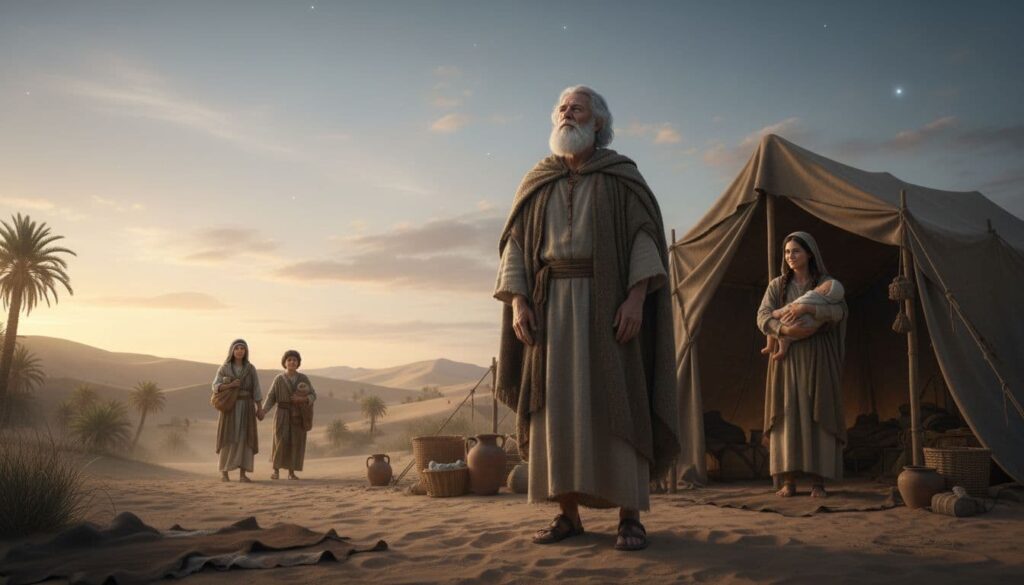
God promised Abraham that He would make a people and bless the nations through him. Abraham believed, and God counted it as righteousness. The covenant in Genesis 12, 15, and 17 sets the pattern. God creates a people by promise, protects them, and uses them to bless the world.
But Abraham and Sarah grew impatient. Sarah gave Hagar to Abraham, and Hagar bore Ishmael. Ishmael was real and loved by God, yet he stands as a picture of human effort in the flesh, not the line of the promise. Years later, God gave Isaac to a postmenopausal woman, the child of promise, born by God’s Word and timing, long after possible by human means.
The New Testament explains the lesson. Ishmael was born according to the flesh, Isaac according to promise. Those born of promise inherit. Those who rely on the flesh do not. For a quick look at this contrast, see a short note on Galatians 4:23 and a parallel on Galatians 4:29.
This matters for end times. God marks His promise people by faith, not by flesh. He keeps them, just as He kept the promise line through Isaac. In future judgment, God separates those who trust Him from those who mock Him. The promise line points to Christ. All who are in Christ share the blessing and are not appointed to wrath.
God’s covenant with Abraham sets the pattern
Genesis 12, 15, and 17 show God taking the lead. He calls, promises, and seals the covenant. The promise includes land, offspring, and blessing to the nations. This covenant shows God’s long plan to create a people He protects and uses to bless the world. It frames why He will keep Israel and bring many to faith in the Tribulation.
Ishmael, a picture of impatience and the flesh
Ishmael’s birth came from not waiting on God. God cared for him, gave him promises of his own, but the covenant line went through Isaac. The Spirit uses this story to teach a spiritual point. Flesh cannot secure God’s promise. Human effort cannot replace God’s grace. Galatians 4 uses Ishmael and Isaac to show the difference between slavery and freedom, flesh and promise.
Isaac, the child of promise, points to grace and protection
Isaac’s birth was a miracle. It was God’s timing and power, not human strength. Romans 9 says, “Through Isaac shall your offspring be named.” The promise defines who are God’s children. That is our hope in trials and tribulation. God keeps those who are born of promise. He sets limits on evil and secures His own.
Putting 2 Kings 2 and the Tribulation side by side
Here is the picture in plain words.
- In 2 Kings 2, a crowd publicly mocks God’s prophet. Elisha acts in God’s name. Two bears maul 42. Judgment is real, and it is measured.
- In prophecy, 42 months marks a short window when evil is loud and bold. God numbers that time, protects His people, and answers rebellion.
- The back half of the seven years matches this tone. The beast rages for 42 months. Witnesses speak for 1,260 days. The holy city is trampled, yet a faithful group is kept. The pattern holds. Limited time, certain justice, kept people.
For a concise resource on how these time markers tie together in Bible study, you can also scan this overview: What is the significance of the forty-two months in Revelation?.
A quick reference table
| Term in Scripture | Length | Where it appears | What it signals |
|---|---|---|---|
| 42 months | 3.5 years | Rev 11:2, Rev 13:5 | Limited window for trampling and beast rule |
| 1,260 days | 3.5 years | Rev 11:3, Rev 12:6 | Counted witness and protected remnant |
| Time, times, half a time | 3.5 years | Dan 7:25, Dan 12:7, Rev 12:14 | Set period of oppression with limits |
| Seven years | Two halves of 3.5 | Dan 9:27 | Final period split at the midpoint |
Conclusion
Here is the takeaway:
First, 2 Kings 2:23-25 is not random. In the Hebrew, it shows public contempt for God’s prophet and a counted act of justice.
Second, the number 42 is a pattern. It points to limited, measured times of testing and judgment, which best fits the back half of the seven-year Tribulation.
Third, God does not pour out His wrath on His people. He saves, seals, and keeps those who trust Him. Abraham, Ishmael, and Isaac teach the same lesson. The flesh cannot inherit the promise, but faith does.
If you face trials and tribulation now, or you are studying the Tribulation ahead, trust Christ today. Rest in God’s set limits and His steady love. God counts the days, keeps His people, and finishes His promise.
Return to homepage.

